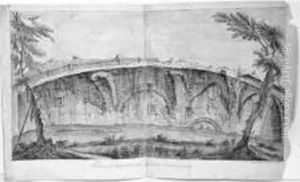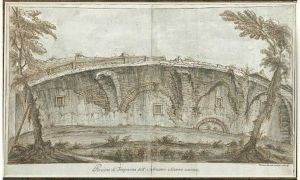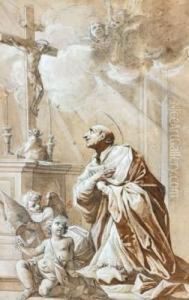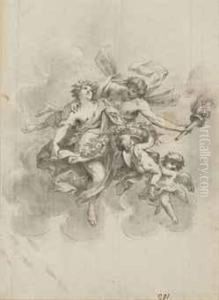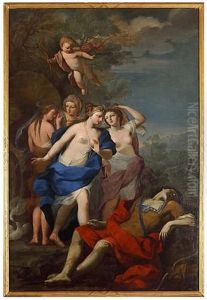Vincenzo Meucci Paintings
Vincenzo Meucci was an Italian painter of the late Baroque period, active mainly in Florence. He was born in 1694 in Florence, the capital of the Grand Duchy of Tuscany. His early life is not well documented, but it is known that he was initially trained by the painter Antonio Domenico Gabbiani. Gabbiani was a prominent Florentine painter of the time, and his influence is evident in Meucci's early works.
Meucci's career began to flourish after the death of his teacher Gabbiani in 1726, as he started to receive more commissions and recognition. He became a respected figure in the Florentine art scene and was known for his religious compositions, frescoes, and altarpieces. His style was characterized by a blend of the dynamism found in Baroque art with the emerging Rococo aesthetic, which favored lighter colors, graceful figures, and a more playful approach to composition.
Among his significant works are the frescoes in the cupola of the baroque church of San Gaetano in Florence, which depict scenes from the life of St. Cajetan, the founder of the Theatine order. He also painted the ceiling fresco in the Corsini Chapel of the church of Santa Maria del Carmine in Florence, which represents the 'Glory of St. Andrea Corsini'. Meucci was also active in painting grand ducal villas and worked for the Medici family, the ruling house of Tuscany at the time.
Throughout his career, Meucci collaborated with other artists and was part of the Accademia delle Arti del Disegno in Florence. His works were appreciated for their vivid color palette and his ability to convey movement and emotion. Meucci's religious paintings were particularly revered for their devotional intensity and for the skillful way he rendered the human form.
Vincenzo Meucci continued to work and contribute to the Florentine art scene until his death in 1766. His legacy is preserved in the numerous works he left behind, which can still be seen in churches, public buildings, and galleries in Florence and other parts of Italy. His contributions to the transition from Baroque to Rococo in Italian painting have been acknowledged by art historians, and his works are studied for their artistic and historical significance.
